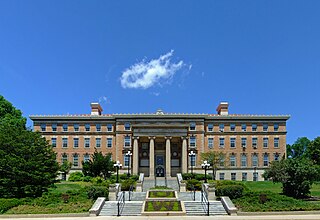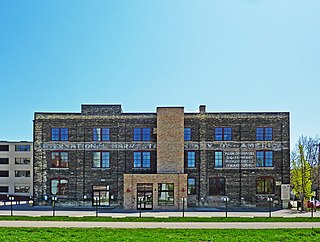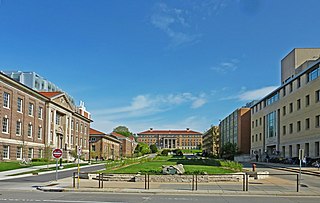
The Wisconsin State Capitol, in Madison, Wisconsin, houses both chambers of the Wisconsin legislature along with the Wisconsin Supreme Court and the Office of the Governor. Completed in 1917, the building is the fifth to serve as the Wisconsin capitol since the first territorial legislature convened in 1836 and the third building since Wisconsin was granted statehood in 1848. The Wisconsin State Capitol is the tallest building in Madison, a distinction that has been preserved by legislation that prohibits buildings taller than the columns surrounding the dome. The Capitol is located at the southwestern end of the Madison Isthmus. The streets surrounding the building form the Capitol Square, which is home to many restaurants and shops.

The First Unitarian Society of Madison (FUS) is a Unitarian Universalist congregation in Shorewood Hills, Wisconsin. Its meeting house was designed by Frank Lloyd Wright and built by Marshall Erdman in 1949–1951, and has been designated a U.S. National Historic Landmark for its architecture. With over 1,500 members, it is one of the largest Unitarian Universalist congregations in the United States.
Arthur Peabody was the campus architect for the University of Wisconsin from 1905 to 1915 and the state architect of Wisconsin from 1915 to 1938.

This is a list of the National Register of Historic Places listings in Dane County, Wisconsin. It aims to provide a comprehensive listing of buildings, sites, structures, districts, and objects in Dane County, Wisconsin listed on the National Register of Historic Places.

The Wisconsin Historical Society is simultaneously a state agency and a private membership organization whose purpose is to maintain, promote and spread knowledge relating to the history of North America, with an emphasis on the state of Wisconsin and the trans-Allegheny West. Founded in 1846 and chartered in 1853, it is the oldest historical society in the United States to receive continuous public funding. The society's headquarters are located in Madison, Wisconsin, on the campus of the University of Wisconsin–Madison.

The University of Wisconsin Dairy Barn is a building located on the campus of the University of Wisconsin–Madison. Built in 1897, the building played an important role in the field of dairy science during the 20th century. It has been used both as a teaching facility and as a site for agricultural research. It is significant for its association with the single-grain experiment, performed from 1907 to 1911 by Stephen Babcock. The UW Dairy Barn was declared a National Historic Landmark in 2005.
The University of Wisconsin–Madison Lakeshore Nature Preserve is a 300-acre (1.2 km2) nature reserve along 4 miles (6.4 km) of the southern shore of Lake Mendota. The preserve's primary goals are to protect native plant and animal communities, as well as to uphold the campus's signature natural landscapes, all while providing an educational facility for the university.
Edwin Niblock Lightfoot Jr. was an American chemical engineer and Hilldale Professor Emeritus in the Department of Chemical and Biological Engineering at the University of Wisconsin-Madison. He is known for his research in transport phenomena, including biological mass-transfer processes, mass-transport reaction modeling, and separations processes. He, along with R. Byron Bird and Warren E. Stewart, co-authored the classic textbook Transport Phenomena. In 1974 Lightfoot wrote Transport Phenomena and Living Systems: Biomedical Aspects of Momentum and Mass Transport. Lightfoot was the recipient of the 2004 National Medal of Science in Engineering Sciences.

The Agriculture Hall is located on the campus of the University of Wisconsin–Madison and first held classes in the fall of 1903. It was added to the National Register of Historic Places in 1985.

The Badger State Shoe Company is a historic building located at 123 North Blount Street in Madison, Wisconsin. It was added to the National Register of Historic Places on April 11, 1989.

The Baskerville Apartment Building is located in Madison, Wisconsin, United States. It was added to the National Register of Historic Places in 1988.

The Bellevue Apartment Building is a historic residential building located at 29 East Wilson Street in Madison, Wisconsin, United States. It was completed in 1914 and was added to the National Register of Historic Places on March 13, 1987.

Lathrop Hall is located on the University of Wisconsin-Madison in Madison, Wisconsin. It was added to the National Register of Historic Places in 1985.

The McCormick–International Harvester Company Branch House is located in Madison, Wisconsin. It was built in 1898 and added to the National Register of Historic Places in 2010.
The Wisconsin Energy Institute serves as a hub for clean energy research for the University of Wisconsin-Madison campus and greater Midwestern region, and houses the Great Lakes Bioenergy Research Center and the Center for Renewable Energy Systems, along with research space for the Nelson Institute for Environmental Studies.

The Hector F. DeLuca Biochemistry Building, originally known as the Agricultural Chemistry Building, is a historic structure on the campus of the University of Wisconsin–Madison. It was the site of the discovery of vitamins A and B, as well as the development of vitamin D processing.

The Old U.S. Forest Products Laboratory is located in Madison, Wisconsin.

















